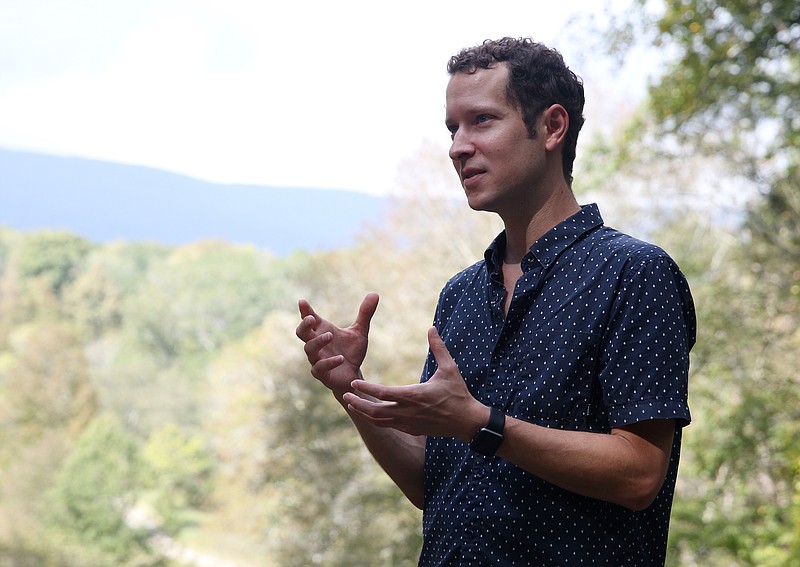A 7.6-acre site along Lookout Creek at the foot of Lookout Mountain where Union troops once confronted Confederate pickets will now be protected land.
The city of Chattanooga was one of three recipients last week of a pass-through Battlefield Land Acquisition Grant from the National Park Service's American Battlefield Protection Program. The land, for which the city will get $353,522.19 to help protect (and which required matching money from other groups), is part of the Lookout Mountain Battlefield and adjoins the Reflection Riding Arboretum and Nature Center.
In late 2021, a grant to the city of nearly $2 million through the same organization and the American Battlefield Trust was made to preserve Reflection Riding's 301.64 acres, though Reflection Riding retains the property.
Similar to Reflection Riding's focus following its protection with the help of the American Battlefield Protection Program, the 7.6 acres will not only be preserved as a battlefield site but also for its general conservation value and specifically for its water quality and floodway component along Lookout Creek, according to Jim Ogden, chief historian at the Chickamauga-Chattanooga National Military Park.
James Modick, lead grant management specialist for the American Battlefield Protection Program, said funding is given for land within a battlefield study area as outlined in a 1993 report by the Civil War Sites Advisory Commission but outside of any current holdings of the National Park Service (NPS), and allows state and local government entities to join with the NPS to protect land.
"We're excited about [Chattanooga's] effort to protect the lands around these historic areas," he said.
We think the idea of shared responsibility, rather than the federal government simply scooping up the land, is the right way to go. And the land is preserved in perpetuity, as are NPS holdings.
On Nov. 24, 1863, Confederate forces held the top of Lookout Mountain but had seen their position on Orchard Knob in the valley overrun the day before and given them concerns about their strength along Missionary Ridge.
Ogden said an assault by Union forces straight up the face of Lookout Mountain was not practical, but Union Gen. Ulysses S. Grant gave Gen. Joseph Hooker permission to move up from the western side to the Confederates' left flank and rear.
Under Gen. John W. Geary, Union troops moved across Lookout Creek at what Ogden said is now the southwest corner of the Reflection Riding property. From there, around 8:30 a.m. and in a heavy fog, they created a line beginning at the creek and extending up the mountain, below the Confederate position.
They first encountered Confederate pickets, or skirmishers, on or around the property just given to the city to protect, Ogden said. The line, he said, then swept up the western slope, around the tip and over on the east side to the still existing Cravens House. By 2 p.m., the battle - often called the "Battle Above the Clouds" - was over. That evening, the Confederates withdrew from the mountain and moved to reinforce Missionary Ridge.
Ogden said in the case of the 7.6-acre property on Garden Road, the owners approached the nonprofit American Battlefield Trust (formerly the Civil War Trust) about the largely undeveloped land. Since it was part of the battlefield, it proved to be a "willing buyer, willing seller" deal, he said.
The nonprofit American Battlefield Trust has helped saved some 404 acres of battlefield land in Chattanooga, the organization said.
Less than three weeks ago, Rocky Face Ridge Park opened in Whitfield County, Ga. Just as the American Battlefield Protection Program worked through Chattanooga on the Reflection Riding land and the recent adjoining 7.6 acres, it worked through Whitfield County to acquire parts of the 1,000-acre park site.
The park contains numerous Civil War fortifications and was the site of two battles during the war.
"The Atlanta Campaign begins here," Ogden said at the grand opening of the park, according to the Dalton Citizen News. "While there will be more and bigger battles to the south, the campaign that will allow [Union Gen. William T.)] Sherman in early September [1864)] to communicate to Ulysses S. Grant and President Lincoln 'Atlanta is ours and fairly won,' that campaign began here. This story is one that can now be better told."
Also similar to the various matching funds that were raised for the Chattanooga sites, a number of public and private entities contributed money for the Georgia park. Among them were Dalton Utilities, the Lyndhurst Foundation in Chattanooga, the Community Foundation of Northwest Georgia, the Riverview Foundation in Chattanooga and Save the Dalton Battlefields.
Battlefield preservation, thus, does not have to be solely a federal project. Indeed, the more collaborators involved, the more ownership there is in the project. And the more who want to make sure that history is preserved properly for future generations.
